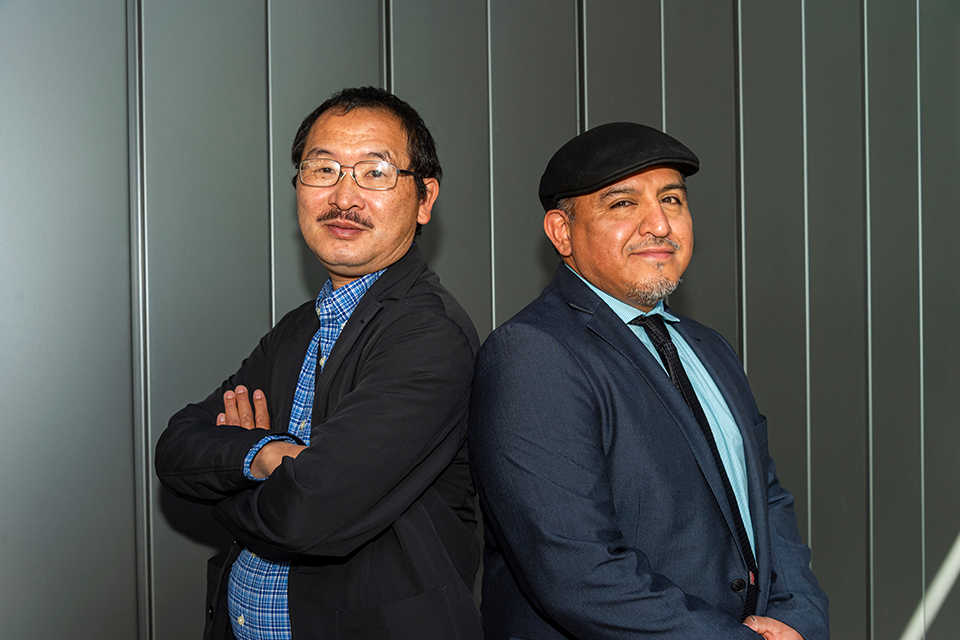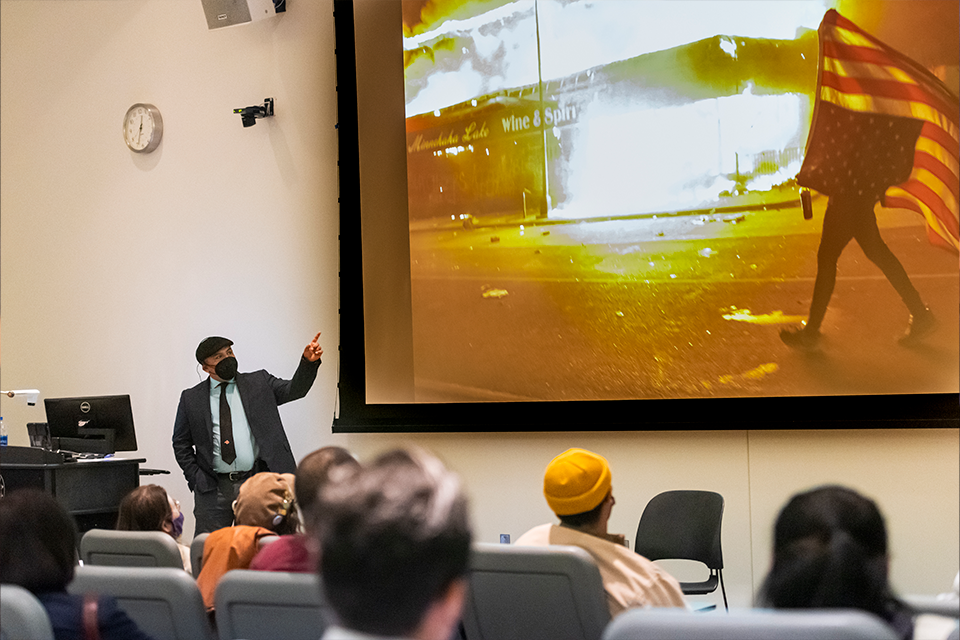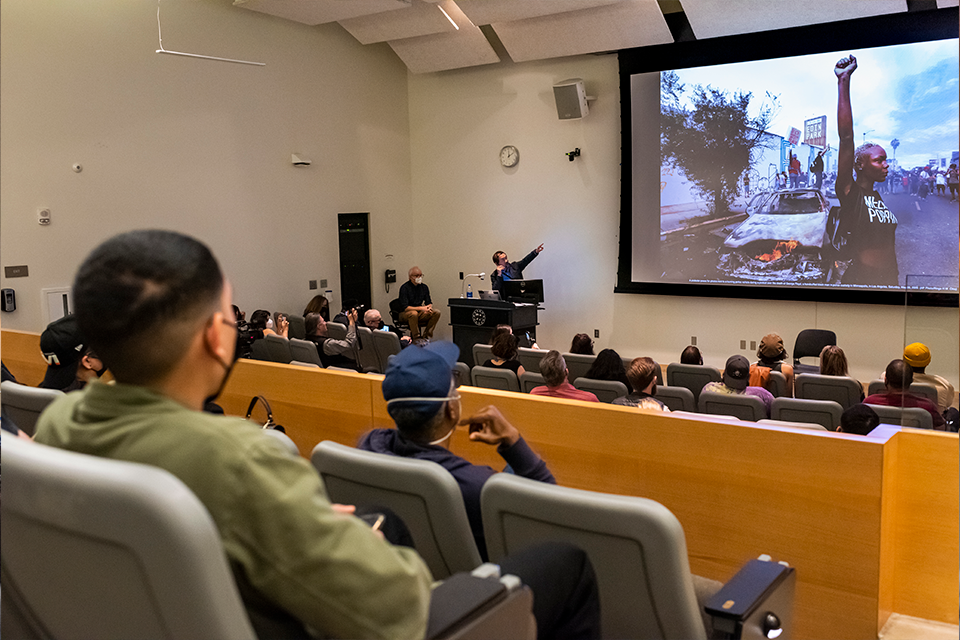During a Week of CSUN Returns, Pulitzer Prize-Winning Alumni Return to Inspire Students on Campus
Every picture is said to tell a story.
But in a rare opportunity, CSUN students heard the stories behind the exceptional pictures of two Pulitzer Prize winners at an in-person campus event at Kurland Lecture Hall on Feb. 16.
Photojournalists and CSUN alumni Julio Cortez ’06 (Journalism) and Ringo Chiu ’01 (Special Major-Journalism), part of the 10-member Associated Press crew of camera artists who were honored for their 2020 pictures of countrywide George Floyd protests, spoke about their winning photos and professional portfolios.
But what resonated most for many in the audience of nearly 100, was the connection they felt to the photojournalists and fellow Matadors, who provided advice about education, the craft and careers.
“Being able to hear their experiences, it helps give a clearer path for students,” said Kaitlyn Lavo, a senior journalism major and photo editor of The Sundial. “We’re students. We’re trying to figure it out. Life is hard in general; trying to figure out a career on top of that is challenging. But hearing people who have already experienced it and are out there doing it and being able to get to that level, that’s inspiring — especially knowing that’s attainable for us CSUN students.”
Cortez and Chiu are two of seven CSUN alumni journalists who have won the Pulitzer Prize — a list which includes Frank Del Olmo, Reed Saxon (who was in attendance), Stephanie Bluestein, Paul Pringle and Veronica Rocha.
Cortez and Chiu spoke while slideshows of their eclectic portfolios played on a giant projector screen. Their evocative photos showed scenes of joy, despair, disaster, economic struggle, celestial bodies, human conflict, environmental conflict, victory, defeat, urban life, botanical life, and life during the COVID-19 pandemic.
Each presentation was centered around their Pulitzer Prize-winning photographs. Chiu, a freelance photographer and longtime contributor to the Associated Press, covered the scenes of George Floyd protests on May 30, 2020, in the Fairfax District of Los Angeles. He saw a charred car and a woman standing in front of it while a ring of protestors surrounded the focus of the action. Chiu showed the six photographs he took of the scene, providing a timeline for the shot that eventually won him acclaim.
“Every shot you see, I try to get the background,” Chiu said. “I love this picture. I see the girl — I don’t know who this lady is. You see the sky, it’s kind of overcast. Behind her is a burning car. In front of her, the people. And you try to separate the two worlds. I saw power, [people] are fighting for something.”
Chiu began his talk speaking about his own determination and his background, immigrating from Hong Kong and matriculating at CSUN, where a professor linked him to an internship that helped launch his professional photographic career in the United States.
Cortez, similarly, was not born in the U.S. He immigrated from Mexico and dipped his first toe in the journalism waters at his junior high school newspaper. His journey included a lengthy process to earn citizenship and seven years in community college, before earning a degree at CSUN and also launching his career through an internship.
The Associated Press photojournalist’s Pulitzer Prize-winning photograph was taken in Minneapolis, the city where Floyd was murdered, during protests on May 28, 2020. The photograph showed a man, hidden behind an American flag he held upside down, walking alone during the evening through a chaotic street while a building and powerlines were ablaze.
Cortez showed the raw images that set up the shot and described how timing, skill, experience and journalistic ethics all came together to create the winning photograph. He also described to the audience of students how they are capable of doing the same kind of work.
“It doesn’t matter what you look like or how you’re built, your mind makes the pictures,” he said. “Your brain makes the pictures.”
Jose Fraire, a junior journalism major and first-generation college student, saw himself in Cortez’s story, as both share Latino heritage. Fraire’s mother is from El Salvador and his father is from Mexico. He noted how valuable it is to have alumni return to campus and tell their stories.
“It shows that anybody can make it,” Fraire said. “And it’s also very valuable to get advice from someone that it speaks to the type of courses we have here and faculty we have here.”
This event was meaningful in showing the impact alumni have on students, but it took on extra meaning as one of CSUN’s first in-person events for the student body in two years. On Feb. 14, CSUN opened the largest slate of in-person classes since March 2020, when the pandemic led the university to a virtual, then mostly virtual, learning environment.
“It’s wild having an in-person event,” Lavo said. “It has a different energy than being on Zoom. You actually can connect with the people. You can actually feel each other’s energy because you’re in the same room together.”




 experience
experience